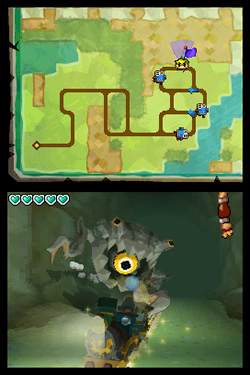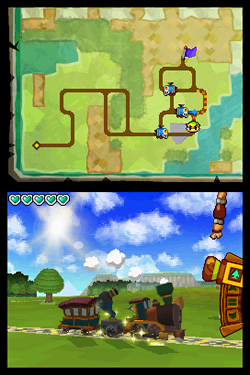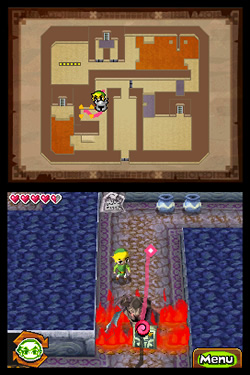The Legend of Zelda: Spirit Tracks (Nintendo DS) Review
By Adam Riley  28.12.2009
28.12.2009

When Nintendo opted to bring The Legend of Zelda: Twilight Princess to the GameCube and Wii, the company had buckled under the weight of fans that eagerly wanted a more mature Zelda experience following the cel-shaded adventure, Wind Waker, which appeared on GameCube. However, in doing so, it risked alienating newcomers that actually preferred the younger-looking Link. As a result, Wind Waker's visual style was resurrected for Phantom Hourglass on the DS two years ago to appease any dissenters. After proving to be a rip-roaring success across the world, that model has been taken and built upon for a new portable outing in the form of The Legend of Zelda: Spirit Tracks. Followers of the RPG series have definitely been eagerly awaiting the next entry, so expectations are certainly high.
Originally the plan for Spirit Tracks was that Zelda would not be a main feature in the game. However, given its status as being part of the long-running series, The Legend of Zelda, it is no surprise that the decision was reversed. This time round, players take control of a young wannabe-engineer, who must first learn to drive a train and then pass his engineering exam. Little does he know that soon Princess Zelda will have her body snatched away, the Spirit Tower will be devastated and the Spirit Tracks around the world will be almost completely wiped out, leaving him to pick up the pieces and save the day. All in a day's work, right?
Immediately players are thrown into controlling Link via use of the stylus and touch-screen for general movement and interaction with villagers, objects or items lying around. After becoming accustomed to using the touch-screen alone for all aspects of play, the first new mechanic is introduced, driving a train. As with Phantom Hourglass, where a route had to be physically drawn on an in-game map for the ship to sail to different locations, the same is true here when riding along the railway tracks. Players can also make notes on the actual maps themselves to prevent forgetting useful information or specific directions that need to be taken (the same goes for nearly all in-game maps; very useful for puzzle solving later down the line). Whilst travelling along there is the opportunity to change to an alternative set of tracks in order to head to another location (by manipulating sets of points at the appropriate time), defend the train against a variety of enemies that try to slow your progress (using weapons that can be attached to the train), carry passengers and freight items (adhering to the trackside signage to appease picky folk; tooting the horn when indicated, sticking to designated speed limits, stopping at stations smoothly, and so on), as well as even catching rabbits en-route that can be reared at a special ranch. There is definitely plenty to deal with en-route to new locations.

An aspect akin to its predecessor is how Spirit Tracks is a complete joy to look at, with vibrant colours bursting from the DS screens on a constant basis. Nintendo has taken the already existing game engine and tweaked it slightly to make this new title look almost as good as Wind Waker did on the GameCube. The similar-but-slightly modified aspects are not solely limited to the visual side either, with the soundtrack bringing back familiar tunes, but adding a whole slew of musical pieces that range from haunting to peaceful and even upbeat and catchy. No expense appears to have been spared on making the presentation levels as high as is expected of a mainline Nintendo release and Spirit Tracks pushes the DS hardware considerably.
There are several new elements, other than the train riding, thrown in for good measure. Whilst the standard dungeon crawling and puzzle solving elements and grand-scale boss fights are all present and correct, a few extras have been slipped in to augment the overall experience. Old school Zelda fans will be pleased to find that Link must traverse the world to reach dungeons (set to backgrounds featured in most other Zelda games - forest, snow and fire settings, to name just a few) filled with the tried-and-tested slew of pesky enemies, moving-block puzzles, locked doors with keys hidden elsewhere, and switch-hitting shenanigans. Those that were enamoured with Phantom Hourglass will also be overjoyed that the boomerang item makes a comeback (with its route drawn out using the stylus), as well as patterns needing to be uncovered by making clever use of the map noting ability and then copying said pattern onto special doors to open up new paths.

In order to stop this feeling a tad too familiar, however, there are a few new extras such as the ability to blow into the microphone to send a whirlwind flying out ahead of Link (blowing out flames, stunning enemies, carrying items over gaping holes, and so on), or using a whip to grab hold of wooden protrusions so Link can swing across gaping chasms, and even a musical instrument – pretty much a set of panpipes that can be played simply by blowing into the microphone whilst moving it from side-to-side to change notes as required (special tunes are learned throughout the game for uncovering items, healing Link and so on).
On top of this, Link receives a little help from the disembodied spirit of Princess Zelda. At certain stages of the adventure she can jump into large armour-plated Phantoms that are controlled by drawing out a path on the touch-screen with the stylus. She can then be used to distract other Phantoms that would otherwise despatch Link with one hefty blow, block flames so a path can be navigated across safely, or even carry Link across lava by walking through it with the little green Hylian Hero sat atop the Phantom’s shield held above its head. Having a helping hand does not necessarily make progression a complete breeze, instead allowing the development team to craft some rather sneaky puzzles, with a few requiring the Phantom and Link to switch places regularly using teleportation around a floor. Considerable thought has gone into making the whole game feel considerably like past Zelda titles, whilst working hard to ensure there is plenty of new content that fits smoothly into the adventure, and the effort certainly has paid off with the balance being very pleasing indeed.

There will be some that find the constant travelling around via train, whilst more enjoyable than going by boat, rather a tiresome process, especially when traversing long distances. However, Nintendo has tried to alleviate such issues by including shortcuts and warp points that open up further into the adventure, thus bypassing the initial ennui inflicted by moving around the world on the slow steam train. Additionally, there are plenty of enemy encounters to keep people on their toes, as well as the interesting inclusion of passengers joining you en-route to different places. With passengers on-board, special care must be taken to change speed at certain marker points, blow the horn when required and generally be at their beck and call in order to ensure total customer satisfaction. So the problem of travelling seeming like a chore at the start of the game is assuaged not too far into the adventure.
Another potential bug-bear for many will be the constant use of the microphone. Whilst Nintendo has cleverly integrated use of the in-built DS microphone to let players blow mini cyclones around (for stunning enemies, wafting away piles of leaves and even helping to solve puzzles, such as launching bombs across gaping chasms to blow-up far away blocks) and play the various useful musical pieces accrued throughout the journey on Link’s panpipes, it brings up the small matter of players having to regularly huff and puff away. This proves both tiresome at times, as well as quite embarrassing whilst playing in public locations. Also, should you be in a noisy area, the game will think you are constantly blowing into the mic to play the instrument or use the cyclone item, making specific sections of the game unplayable in busy public areas.
Finally, moving on from the minor negative issues, there is a little something extra for those that have up to three friends with Nintendo DS systems (only one game cartridge is needed, thankfully). Nintendo has included a four-player competitive mode where friends and family can battle it out as one of four coloured Link characters to collect as many Force Gems as possible, tripping each other up in the thick of the action by using lightning jolts, pitfalls and more. Additionally, valuable treasure items can be wirelessly traded with others to complete the in-game collection. This is one of the most complete Zelda packages available and whilst it distances itself from the realistic visuals of Twilight Princess, Majora's Mask and Ocarina of Time, it certainly does not mean this is inferior to those classic adventure romps in any sense of the word.

Cubed3 Rating
Exceptional - Gold Award

Nintendo struck gold with Phantom Hourglass, but this new Zelda adventure builds upon that strong foundation considerably to deliver one of the best outings in the long-running series so far. It may not be completely flawless, but The Legend of Zelda: Spirit Tracks is definitely one of the DS 'must own' titles of 2009.

![]() 9/10
9/10
![]() 7/10
(15 Votes)
7/10
(15 Votes)
 Out now
Out now  Out now
Out now  Out now
Out now  Out now
Out now Comments
Comments are currently disabled

 Sign In
Sign In Game Details
Game Details Subscribe to this topic
Subscribe to this topic Features
Features





 Top
Top

